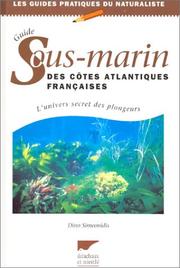Book
Abstract | Keywords | Export | Availability | Bookmark
 Loading...
Loading...Choose an application
- Reference Manager
- EndNote
- RefWorks (Direct export to RefWorks)
Book
Year: 2020 Publisher: London, England : IntechOpen,
Abstract | Keywords | Export | Availability | Bookmark
 Loading...
Loading...Choose an application
- Reference Manager
- EndNote
- RefWorks (Direct export to RefWorks)
Invasive alien species (IAS) are a menace to agricultural crops and ornamental plants worldwide due to climate change and global warming. They vector serious human and animal diseases and endanger biological diversity through competition and niche displacement. This book addresses issues pertaining to introduction pathways of invasive species, their bionomics, dispersal, risk assessment, economic impact, and possible management and control options. It provides comprehensive information on global invasion, economic impact, and management options for the red palm weevil, spotted wing Drosophila, and the South American tomato pinworm. Additionally, it examines the economic utilization of invasive plant species from the families Asteraceae and Cactaceae as means of management. University teachers and researchers in the fields of entomology, ecology, and environment, as well as students, will find this book useful.
Book
ISBN: 1534544100 Year: 2023 Publisher: New York : Greenhaven Publishing LLC,
Abstract | Keywords | Export | Availability | Bookmark
 Loading...
Loading...Choose an application
- Reference Manager
- EndNote
- RefWorks (Direct export to RefWorks)
"Genetically modified organisms have been the subject of much debate among the scientific and holistic communities. Some people believe GMOs are harmful to people and animals, whether ingested or used in cosmetics. Rigorous scientific research has so far shown that there is no danger to living beings from GMOs. With nearly 100 percent of several major crops coming from GMOs in the 21st century, learning more about the history and methods of bioengineering is crucial to becoming a well-informed consumer. In-depth sidebars and engaging graphic organizers help dispel myths and address the reality of bioengineering in the agricultural sector"--
Book
ISBN: 3038429767 Year: 2018 Publisher: Basel : MDPI,
Abstract | Keywords | Export | Availability | Bookmark
 Loading...
Loading...Choose an application
- Reference Manager
- EndNote
- RefWorks (Direct export to RefWorks)
Microbial communities are networks of species, the interaction structure of which dynamically reorganizes in a varying environment. Even in a static condition, community dynamics are often difficult to predict due to highly nonlinear interspecies interactions. Understanding the fundamental principles of microbial interactions is therefore key for predicting and harnessing community function and properties. As extensively reviewed previously, mathematical models and computational methods that can predictively link interactions to community behaviors are indispensable tools for achieving this goal.
Microorganisms. --- Germs --- Micro-organisms --- Microbes --- Microscopic organisms --- Organisms --- Microbiology
Book
ISBN: 9264250441 9264253017 9789264253018 Year: 2016 Publisher: Paris : OECD Publishing,
Abstract | Keywords | Export | Availability | Bookmark
 Loading...
Loading...Choose an application
- Reference Manager
- EndNote
- RefWorks (Direct export to RefWorks)
This series represents a compilation of the biosafety consensus documents developed by the OECD Working Group on Harmonisation of Regulatory Oversight in Biotechnology over the periods 2011-12 (Volume 5) and 2013-15 (Volume 6). Volumes 5 and 6 describe the biology, centres of origin, genetics, hybridisation, production and use, and ecology elements of several crops (sugarcane, cassava, sorghum, common bean, cucurbits) and trees (eucalyptus species). They also provide considerations on pathogenicity factors in assessing the potential adverse health effects of bacteria, and the low level presence of transgenic plants in seed and grain commodities. The consensus documents contain information for use during the regulatory assessment of products of modern biotechnology, i.e. transgenic organisms (plants, animals, micro-organisms), when intended for release in the environment. As such, it should be of value to applicants for use of genetically-engineered organisms in agriculture mainly, to regulators and risk assessors in national authorities for their biosafety assessments, as well as the wider scientific community. More information on this OECD programme is found at BioTrack online (www.oecd.org/biotrack).

ISBN: 2603010484 9782603010488 Year: 1997 Publisher: Lausanne: Delachaux et Niestlé,
Abstract | Keywords | Export | Availability | Bookmark
 Loading...
Loading...Choose an application
- Reference Manager
- EndNote
- RefWorks (Direct export to RefWorks)
Book
ISBN: 9781849712286 184971228X 9780815378716 0815378718 Year: 2012 Publisher: Washington : Earthscan,
Abstract | Keywords | Export | Availability | Bookmark
 Loading...
Loading...Choose an application
- Reference Manager
- EndNote
- RefWorks (Direct export to RefWorks)
Book
Year: 2013 Publisher: [Reston, Va.] : U.S. Department of the Interior, U.S. Geological Survey,
Abstract | Keywords | Export | Availability | Bookmark
 Loading...
Loading...Choose an application
- Reference Manager
- EndNote
- RefWorks (Direct export to RefWorks)
Mitochondrial DNA. --- Aquatic organisms --- Introduced organisms
Book
Year: 2016 Publisher: [Silver Spring, Md.] : United States Department of Commerce, National Oceanic and Atmospheric Administration,
Abstract | Keywords | Export | Availability | Bookmark
 Loading...
Loading...Choose an application
- Reference Manager
- EndNote
- RefWorks (Direct export to RefWorks)
Introduced organisms --- Introduced freshwater organisms --- Control --- Management.
Book
ISBN: 044313832X 0443138311 9780443138324 Year: 2024 Publisher: San Diego : Elsevier,
Abstract | Keywords | Export | Availability | Bookmark
 Loading...
Loading...Choose an application
- Reference Manager
- EndNote
- RefWorks (Direct export to RefWorks)
This comprehensive book, 'Membranes for Water and Wastewater Treatment: Principles and Applications,' explores the critical role of membrane technology in addressing global water challenges. Authored by experts from Tongji University, it delves into the principles, design, and applications of various membrane types, emphasizing the mitigation of biofouling—a significant hurdle in membrane efficiency. The book consolidates evolving knowledge in membrane technology, offering insights into preparation methods, antiadhesion strategies, and the use of biocidal nanomaterials. It is designed for researchers, engineers, and graduate students, providing a deep dive into both theoretical and practical aspects of membrane technology, with a focus on real-world applications and future challenges.
Membranes (Technology) --- Fouling organisms. --- Fouling organisms

 Search
Search Feedback
Feedback About UniCat
About UniCat  Help
Help News
News